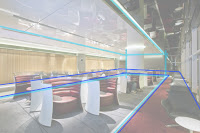Kevin Lynch introduced the five elements of a city – path, edges, district, nodes and landmarks. He was referring these elements in urban design or city planning. Having said that, in our class we were asked to identify these five elements in interior environments and how the architects or designers uses those five elements to help the occupants to sense and response within the interior space.
The first element Path, as defined in “The image of the City” - a book written by Kevin Lynch, “the routes along which people travel.” As designers or architects, they might use a path to direct people from one space and into another. The image above shows a path in a shopping complex, Hong Kong IFC mall. It is a suspended bridge between two departments with a store, confined and defined with light glass boxes of display and railing.
Secondly, Edge as described by Lynch “non-traveled lines as cliffs, or escarpments, or the shores of rivers, lakes or oceans.” Edges in an interior environment are sometimes fenced off, as it sometimes represents a dead end. For example, IFC complex of Shanghai in the image above, shows glass railings used to confine the voids within this space also restricting people from falling through the void.
District as defined by Lynch “moderate – sized areas that city residents identify as having particular character.” In large areas, having districts can be useful for users to navigate through the environment. Architects or designers can be achieved by using different materials, colors, themes and also differencing the floor levels, all those methods will contribute in breaking up the continuality of one large space. For instead, in the photo above is the wood district in Elements mall of Hong Kong. The designer used different elements, such as fire, water, and wood, to define different zones. Hence the interior design would be based on the element of that zone. In this case, the designer used wood materials and color tones to decorate spaces within the zone.
Lynch defined Node as “well – known points that people travel to and from, often at the junction of important paths, such as key intersections, transit terminals and popular plazas or squares.” The image above is the new Cathay Pacific lounge in Hong Kong, offering a comfort area for waiting guests . I have identified the Node in the small image (outlined in light blue), where it sit on the intersection of two paths (highlighted in dark blue.)
The final element, Landmark defined as “easily viewed elements either on grand scale (e. g. the tallest building in town) or on a smaller scale (e. g. a statue or unique storefront).” Landmarks are well known due to its size or uniqueness, therefore they are usually the meeting points or reference points within an interior environment. An example of a landmark would be this gigantic 20 meters tall Christmas tree in Festival Walk of Hong Kong (shown in the image above.)
References -
- http://www.outinhome.com/2010/10/new-seating-system-of-cathay-pacific-lounge-by-foster-partners/
- http://www.elementshk.com/eng/elements/elements.htm
- http://hong-kong-travel.org/
- http://farm3.static.flickr.com/2385/1711155244_3b7aab45bc_o.jpg










No comments:
Post a Comment